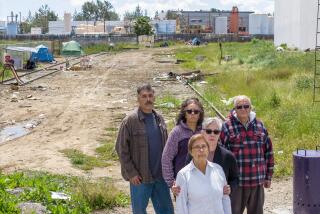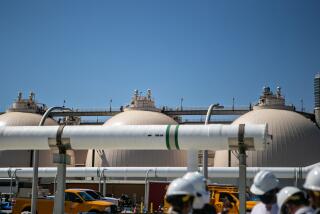Alyeska Cleared of Dumping Oily Sludge at Facility : * Environment: The EPA, however, did call for amending discharge procedures in the Alaska plant. Critics remain skeptical.
- Share via
Dismissing allegations of misconduct against the oil-company consortium that operates the trans-Alaska pipeline, the U.S. Environmental Protection Agency said Friday that empty oil tankers have not been illegally discharging toxic materials at a Valdez treatment facility.
But in a formal response to charges by environmentalists and other critics, the EPA called for amending some procedures at the Alyeska Pipeline Service Co.’s ballast-water treatment plant--notably the practice of accepting water tainted with oil tankers’ engine-room sludge.
Oil industry opponents had complained that tankers arriving to take on oil from the pipeline were discharging ballast water that the treatment plant is not equipped--or legally allowed--to handle. Those critics continued to express skepticism Friday about the EPA’s report.
Tankers, the EPA found, have routinely dumped oily ballast water--some transferred on the high seas from other tankers--at Valdez, instead of disposing of it at West Coast dry docks.
Because the ballast water is released after treatment into Valdez harbor, critics had harged that dumping of tank washings could introduce toxic concentrations of hydrocarbons and other materials into Alaskan coastal waters.
But the EPA found no evidence that harmful substances were being discharged from the plant. So tank-washing transfers will continue to be allowed.
“We were looking for some kind of cause and effect between the acceptance of transferred tank washings at the terminal--what this whole issue was about--and the quality of the effluent from the treatment facility,” said Greg Kellogg, regional chief of water compliance for the EPA.
However, the EPA did decide to ban virtually all tank cleansers containing chlorinated hydrocarbons, which Kellogg describes as the “pollutants of concern.”
The EPA specifically rejected charges by Charles Hamel, a retired Virginia oil-tanker broker and persistent critic of Alyeska, that the Valdez facility was accepting “toxic wastes originating in California.”
Alyeska spokeswoman Marnie Isaacs said, “We’re particularly pleased that the EPA found no evidence that any toxic or hazardous materials had been illegally transported from California.” She also expressed satisfaction that the agency concluded that Alyeska had not violated its permit to operate the Valdez plant.
But Alyeska critics were not so sanguine.
“There has certainly been evidence that contaminated washings have presented an environmental problem at the terminal,” said Joe Bridgman, a staff member of the Regional Citizen’s Advisory Council, an Alaska group set up by federal law as an independent citizens’ watchdog after the Exxon Valdez oil spill.
Others remain skeptical of EPA enforcement capabilities. The EPA “has known about (ballast water contamination) since 1985 and they’ve failed to stop it,” said Riki Ott, president of the Oil Reform Alliance, another Alaska watchdog group.
More to Read
Sign up for Essential California
The most important California stories and recommendations in your inbox every morning.
You may occasionally receive promotional content from the Los Angeles Times.










